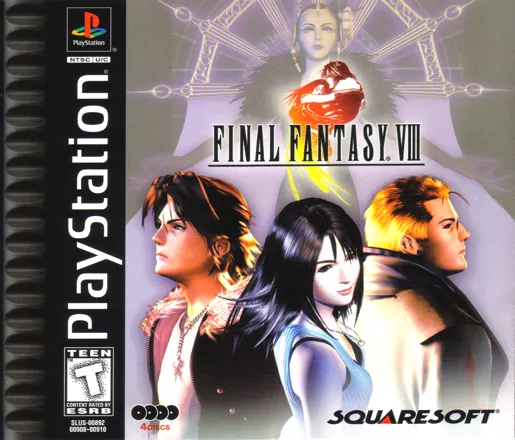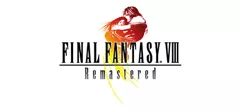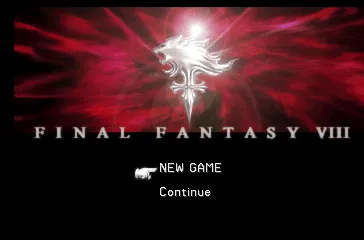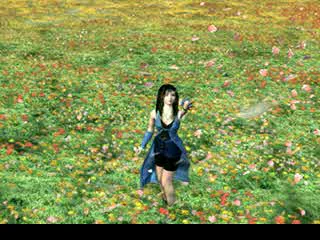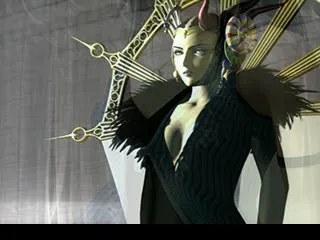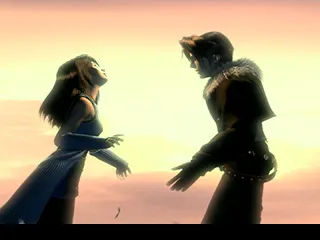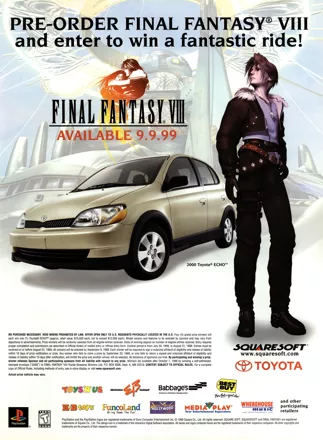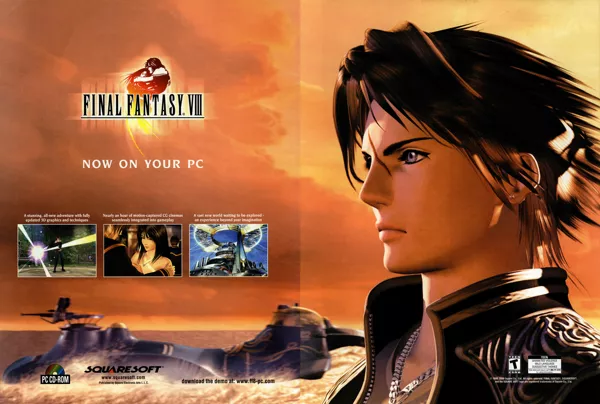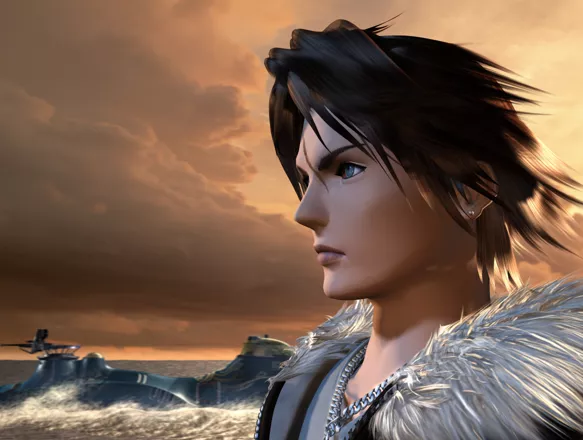Final Fantasy VIII
Description official descriptions
Squall Leonhart is a young man in training to become of member of SeeD - a mercenary organization and the goal of all young students in Balamb Garden. Squall is not a particularly friendly guy and has troubles with his fellow students and teachers. On the eve of his graduation hostilities break out between the city-states of Galbadia and Dollet. As their final test, Squall and three other students are sent on a mission to assist in the fight against Galbadia. In the process they discover that there are other characters pulling strings from behind the stage, and eventually uncover a mystery that involves two decades of secrets hidden both from the world and from themselves.
Final Fantasy VIII is set in a "retro" environment reminiscent in some ways of the 1960's, with a few sci-fi and plenty of supernatural elements mixed in. The basic system resembles those of its predecessors: the player navigates a party of characters over a world map, accessing various locations and fighting randomly appearing enemies in turn-based combat of the series' trademark ATB (active time battle) variety. However, character development system has been re-designed.
Player-controlled characters in the game have no defined character classes. They can be customized by equipping magic spells, which can be "drawn" from enemies in battles. When used in combat, spells act like expendable items; there are no MP (magic points) in the game. When equipped, they act like armor, raising or lowering character parameters, including resistances to various kinds of magic (elemental, status-changing, etc.).
Monster summons (called Guardian Forces in the game) play a very important role in the customization process. They can be "junctioned" to to the characters, acquire ability points (AP) earned from battles along with experience, learn and "teach" characters new abilities, and can also be summoned in battles. Each character can also execute unique powerful attacks or support actions when his or her hit points are low. Many of these attacks require the player to press specific buttons at the right moment to increase their power.
New weapons are constructed by collecting materials and bringing them to a blacksmith. The player does not acquire money from random enemies, but instead receives paychecks over time based on the player character's SeeD rank. This rank increases when the characters defeat enemies in battles without summoning Guardian Forces; when the player takes SeeD tests within the game; or, occasionally, when the player chooses a correspondent action or decision for the protagonist during some of the missions. Payments are regular and are calculated by the amount of steps the characters make.
Visually, the game resembles its predecessor, featuring 3D graphics for battles and world map exploration, and pre-rendered backgrounds for individual locations. The game's 3D character models are realistically proportioned (as opposed to the "super-deformed" character graphics of the previous game), and the influence of anime art is less noticeable.
Like the previous installment, Final Fantasy VIII features several mini-games, the most prominent of which is the card game Triple Triad. Cards can be won in matches or acquired through side quests or by transforming enemy monsters. Many characters in the game can be challenged to a game of Triple Triad, so it is always possible to take a break from saving the world to play cards with the locals.
Spellings
- Финальная Фантазия 8 - Russian spelling
- ファイナルファンタジーVIII - Japanese spelling
- 太空戰士 8 - Traditional Chinese spelling
- 最终幻想8 - Simplified Chinese spelling
Groups +
- Console Generation Exclusives: PlayStation
- Fantasy creatures: Dragons
- Final Fantasy games
- Final Fantasy series
- Game feature: Original theme song
- Games referenced in movies
- Games with post-credits scene or gameplay
- Middleware: Bink Video
- PlayStation Greatest Hits releases
- PlayStation Platinum Range releases
- Video games turned into board / card games
Screenshots
Promos
Credits (PlayStation version)
113 People (107 developers, 6 thanks) · View all
| Executive Producer | |
| Director | |
| Music | |
| Main Programmer | |
| Battle System Designer | |
| Character Design / Battle Visual Director | |
| Art Director | |
| Scenario Writer | |
| Image Ilustration | |
| Movie Director | |
| Movie Character Director | |
| Character Modeling Director | |
| Real-Time Polygon Director | |
| Battle Effect Director | |
| Motion Director | |
| Card Game Director / Battle Camera Director | |
| Lead Field Designer | |
| Event Script Programmer | |
| Battle Programmer | |
| Event Director | |
| Map Director | |
| [ full credits ] | |
Reviews
Critics
Average score: 88% (based on 68 ratings)
Players
Average score: 4.0 out of 5 (based on 347 ratings with 26 reviews)
It doesn't do justice to its predecesors.
The Good
There are lots of original concepts to be found. It gets rid of a lot of RPG cliches such as gathering gold, armors and weapons. Armor is virtually nonexistent, your starting weapon is the standard 1 for your character throughout the whole game. You get paid regualrly so gold is no longer a big reason for killing random enemies. The graphics on the Guardian Forces are impressive the first couple of times you see them, but they get very repetitive.
The Bad
You can't skip the animations on the Guardian Force attacks. The grphics are sub par, they're left in the original playstation resolution which makes them low-res on todays PC's. A lot of the original concepts are poorly implimented.The sounds sound tinny and distant.
The Bottom Line
If you're a Final fantasy fanatic is the only way i can recomend this game. A console port that squaresoft put no effort into. They didn't take advantage of the computers superior performance.
Windows · by jeremy strope (160) · 2000
Junctioning GFs with teenage angst
The Good
After the previous game conquered the masses with its visual splendor and drama, Square decided to go all the way with pomp and fanfares, and released one of the series' most hyped and controversial installments.
However, if you look beyond the often needlessly flashy exterior, you'll find quite an interesting game within. There are some rather extravagant features in the gameplay system. The series' trademark summons (now called GFs) have turned into a universal equipment of sorts, which determines the character's attributes, resistances, and teaches them new abilities. Armor is gone completely, and instead you junction magic spells to your attributes to raise them. This sounds like a crazy, convoluted idea, but once you get the hang of it you might even enjoy the flexibility. Add to that the complexity and the variety of GF-junctioning, the large amount of special abilities those GFs can learn, the usage of GFs themselves as summon spells, the fact that many of them are optional, and you'll get quite a bit of stuff to tinker with.
Though the game is noticeably less open-ended that the previous installments, there are still secrets to discover, including character-related sub-quests, optional boss battles, and large amounts of powerful items to hunt for. A fairly sophisticated card game can be played against various NPCs, yielding even more cool stuff to the player in case of victory.
The melodramatic story of Final Fantasy VIII is not without merit. I liked its soap opera-like tone, its unusual focus on modern-day teenagers instead of knights in shiny armor. Take a look at the famed love story, for example. Old RPGs showed a main hero with big muscles killing the bad guy and getting the girl as a result. Here, the love relationship develops slowly, in an "episodic" fashion, with attention paid to mundane details and crudely presented, but somehow endearing psychological traits. The setting has a certain "1960's vibe" mixed with old-school optimistic sci-fi, reducing medieval fantasy elements to a minimum.
There are plenty of emotional scenes in Final Fantasy VIII, with the famous dance scene stealing the show. That scene is probably the closest thing to TV drama-like entertainment you'll encounter in the world of video games. Generally, the CG movies in this game truly enhance the atmosphere. Instead of being just pointless eye-candy, those (mostly short and silent) sequences serve as little dramatic intermezzi that refresh the narrative and help to emphasize important events by taking them "out" of the gameplay.
Final Fantasy VIII has exquisite visuals. The "realistic" characters were a correct design choice for a game that attempted to move away from epic fantasy towards modern-day melodrama. Graphical details constitute a great deal of the game's special atmosphere: pay attention to some of the characters' clothes and outfits, decorations on the streets in towns, train design, etc. Gorgeous, stylish pre-rendered backgrounds and real-time 3D battle graphics surpass everything the PlayStation has seen before.
The Bad
The gameplay system of Final Fantasy VIII ended up being too ambitious, over-complicating things that should have stayed the way they'd been before. Some of the decisions made by the designers of this game were puzzling, to say the least.
One big problem with the system is the stubbornness with which the designers force the players to use GF attacks and limit breaks over and over again. I understand that boss battles should require more than simply tapping the attack button; but regular battles that drag themselves is a major mood-killer for a Japanese RPG.
The unskippable GF attack animations, admittedly gorgeous, are simply too long, and watching them again and again is a painful process. What's worse is that the player feels too tempted to use them all the time, because they are completely free. Putting a penalty on GF usage (health or MP-draining or whatever) would have at least balanced that part a bit.
An alternative to GF attacks are powerful limit breaks; but you can execute them only if the character in question is on the verge of dying. It sounds interesting in theory, and really proves helpful against bosses; but using this technique against regular enemies again means prolonging the battle. Same applies to the dubious magic-drawing: why can't I just buy spells instead of wasting turns upon turns on getting them from enemies? Regular enemies tend to have ridiculous amount of HP and also inflict ridiculously low damage on your characters. Put all of the above together and you'll have an idea about how tedious and unrewarding the battles of Final Fantasy VIII can become.
Some of the gameplay features in this game simply make no sense. Why do I get paychecks that diminish if I just wander about and don't follow the storyline? Discouraging exploration in an RPG is a cardinal sin. Even worse are enemies who level up together with the player-controlled characters, disrupting the balance and further increasing the player's desire to skip battles. In a Japanese RPG, where combat normally occupies a much more significant portion of the gameplay than in the West, this design flaw can prove lethal.
The ambitions of the story are severely hampered by strange, poorly explained, and needless plot twists. Maybe much of the quality has been lost in translation, but the writing doesn't improve at all over the previous Final Fantasy offerings, which were, frankly, never too good to begin with. The awkward and messy writing hurts Final Fantasy VIII more than it did the early installments, precisely because this game tried to disengage itself from "childish" fantasy elements and declared itself realistic and mature.
Plot holes and unsatisfying explanations become more abundant the more the game abandons its melodramatic tone and plunges into the depths of supernatural cosmic battles. Square didn't dare to pursue their new stylistic approach to the end and inserted a trivial, obligatory "save the world" grand finale, which seemed to have been torn out of context and pasted into the game without any good reason. And again, this damages the game more than it would a more traditional Japanese RPG.
The Bottom Line
Square surely took chances with Final Fantasy VIII. It alienated many fans and is still seen by some as the black sheep of the franchise. While I do not consider it a bad game and appreciate its artistry and its aesthetic value, I have to agree that too much patience is required to wade through lengthy summon animations, weird design elements, and inane plot twists.
PlayStation · by Unicorn Lynx (181780) · 2016
Not as Good as FF7 but still a good game.
The Good
I loved the card game. It was a great idea with all the monsters in the game and all the characters. The way they had the magic was pretty cool.
The Bad
The way they had the magic wasn't as cool as on FF7. The way it would always switch back to that weird guy in "Dreamland" was pretty dumb. Why do all FF games have to have such a weird storyline?
The Bottom Line
A good but not great RPG.
PlayStation · by Attila (553) · 2001
Discussion
| Subject | By | Date |
|---|---|---|
| Game with downloadable sounds soundbank | MerlynKing | Oct 24, 2016 |
| A question-spoilers! | GAMEBOY COLOR! (1990) | Apr 24, 2011 |
| OMG!!! TEH DEVIL!!! | The Fabulous King (1332) | Jul 24, 2007 |
Trivia
1001 Video Games
The PS1 version of Final Famtasy VIII appears in the book 1001 Video Games You Must Play Before You Die by General Editor Tony Mott.
Development
- During production of the game, there were plans to originally call the Rinoa character "Lenore".
- Parasite Eve was the 'testing ground' for the cinematic graphics used in FFVIII.
Innovations
As of 2013, Final Fantasy VIII is the first and the only Final Fantasy game where the playable characters don't equip any armor.
Music
The music in this game was originally composed and recorded as Dolby Digital 5.1, then "dumbed down" to normal stereo for the actual release. The original DD 5.1 score was rumored to be the one to be used in a PlayStation 2 re-release.
Ratings
When it was first released as a demo, it was rated M for strong language but was later toned down to a T rating.
References
- Some names of the Guardian Forces (monsters you can summon in Final Fantasy VIII) are taken from mythologies of different nations. Quetzalcoatl is one of the main gods in the mythology of Central America's Indians; Shiva is God in Hinduism (he appears as a feminine incarnation in the game, although he is normally regarded as male); Diabolos is Greek for "devil"; Cerberus is a three-headed dog which guards the gates of Hades in Greek mythology; Siren is a beautiful and dangerous demi-goddess, also from the Greek mythology; Leviathan is Hebrew for "whale", this word is used to describe the sea monster that swallowed the prophet Jonas in Old Testament.
- The game's most poweful GF is called Eden. This is actually the name of the paradise, "Garden of Eden" (Hebrew "Gan Eden"), from where Adam and Eve were expelled, according to the first book of Moses from the Old Testament. Why is the most powerful GF a garden? Because the universities where the heroes of the game study and train are called gardens. It is logical the most powerful garden is also the most powerful weapon.
- In Esthar there is a shop called Cloud's Shop, a reference to Final Fantasy VII.
- You can spot UFOs during battles in four areas of the world. The sightings are used in the 'Pupu card' sidequest, and can only be seen from the second disk onwards.
References to the game
- In the 2004 Olympics, one of the American synchronized swimming teams chose to use a piece of music from Final Fantasy VIII as their background music . They used the song Liberi Fatali, the game's main theme
- The game is featured in the movie Charlie's Angels. It's the game the two kids are playing in the scene where Drew Barrymore drops naked from Knox's house. Interestingly enough both kids seem to be playing it at the same time, apparently nobody figured to tell the production team that the game was single-player only.
Summonings
When the game came out, the #1 complaint everyone had was that there was no way of skipping the summoning animations - which were essential for making it through the early stages of the game. The creators claimed this was entirely intentional, and that it was somehow vital to the plot that the players be forced to sit through the same minute-long animations hundreds of times. They never changed it in FFVIII (even the later PC adaptation) but oddly, all subsequent Final Fantasy games with summonings include the option to shorten the animation...
Tech demo
The ballroom dance scene was used as the basis for a PlayStation 2 tech demo, showing that the PS2 was powerful enough to render the scene in real-time.
Version differences
- The PC version includes a mini-game called Chocobo World. Previously, this was only available with the Japanese PSX version through the Dex Drive.
- Seifer and Zell, two important characters of Final Fantasy VIII, were renamed to Cifer and Xell, respectively, in the German version, probably because the original names are common German family names and might have possibly offended their innocent bearers.
-
Disc 3 of the Windows version (US release) has a hidden audio track. It contains the song Eyes On Me, sung by Faye Wong. This song was released in Japan as a CD single and was part of the original soundtrack.
-
The original Playstation release included a Chocobo World minigame which required access to a PocketStation, a console that was only released in Japan. Gamers in other territories could only access that by importing a PocketStation from Japan. This was the only way to access some rare items in the game.
Information also contributed by Alan Chan, Foxhack, j. jones, NightKid32, Rey Mysterio, Tiago Jacques, YID YANG, WizardX and Zovni
Analytics
Upgrade to MobyPro to view research rankings!
Related Sites +
-
FF-Fan
A fansite that offers all kinds of information on the entire Final Fantasy franchise, including walkthroughs, game media, discussion boards and fan art. -
FF8 Hints
Final Fantasy VIII hints and solutions -
Final Fantasy Extreme
Site that contains movies, wallpaper, codes, guides, walkthroughs, and general information on the Final Fantasy series. -
GameFaqs Files
Comprehensive links to numerous Final Fantasy VIII files on GameFaqs -
OC ReMix Game Profile
Fan remixes of music from Final Fantasy VIII. -
Wikipedia: Final Fantasy VIII
Information about Final Fantasy VIII at Wikipedia
Identifiers +
Contribute
Are you familiar with this game? Help document and preserve this entry in video game history! If your contribution is approved, you will earn points and be credited as a contributor.
Contributors to this Entry
Game added by Matthew Bailey.
PSP, PlayStation 3 added by Charly2.0. PS Vita added by GTramp. PlayStation added by Grant McLellan.
Additional contributors: MAT, Unicorn Lynx, Jeanne, Silverblade, DarkDante, DreinIX, —-, Paulus18950, Patrick Bregger, Thomas Thompson, Lain Crowley, Rik Hideto, FatherJack, 64er.
Game added March 26, 2000. Last modified March 18, 2024.
